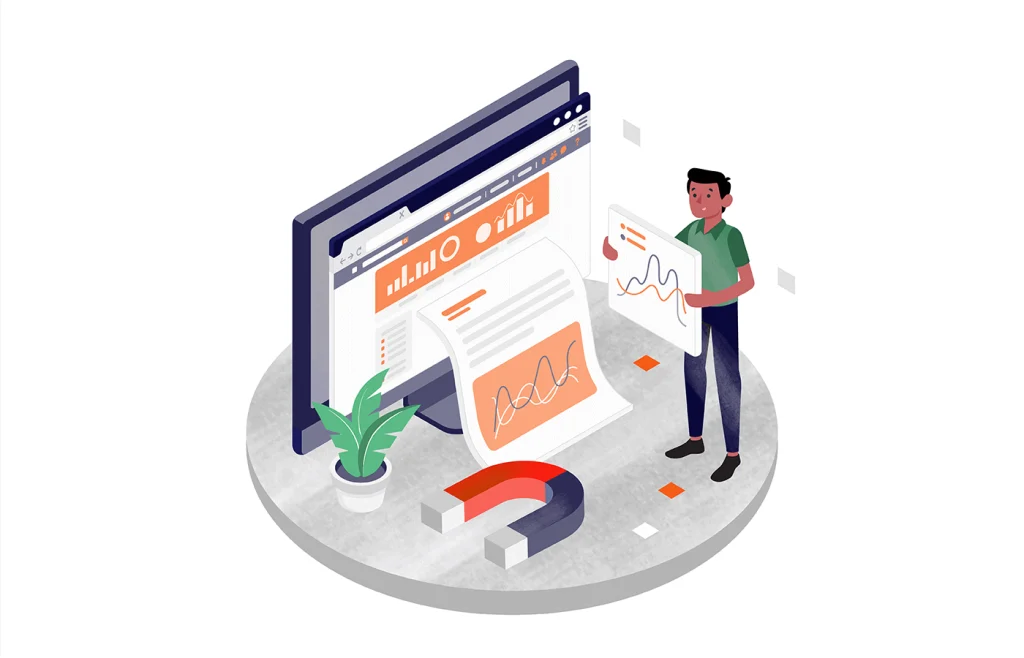More often than not, the role of email marketing in digital marketing is underestimated. Unrightfully so!
It lets you reach your audience directly, delivering valuable messages straight to their inbox to nurture relationships and keep them engaged with your brand. And the best part? This marketing channel is only getting bigger and better each year.
That’s why this guide came to be. Together, we’ll break down everything you need to know about how email marketing works and the effective email marketing techniques that will make it work for you, including some email marketing examples and the best practices for email marketing.
What is Email Marketing?
Usually, email marketing definition explains it as a direct marketing channel where email is used to promote products or services. Businesses send commercial messages to groups of people via email to generate sales or leads. It’s a direct and personalized way to connect with potential and current customers.
Now, while some email marketing is like email advertising, where businesses send email ads to subscribers, there’s much more to uncover. Better think of email marketing as building a relationship. Businesses use targeted emails to connect with a target audience who want to hear from them.
These emails could share articles, remind you about something in your cart, or give you a heads-up on a sale – all personalized based on what you like! It’s about building trust over time so people stick around and become loyal customers
Interestingly, email marketing has come a long way from its early days as simple, often untargeted, text-based blasts. These initial email marketing campaigns were often perceived as intrusive, similar to spam.
However, the emergence of sophisticated email marketing services has transformed the landscape. These services provide tools for precise segmentation, personalized messaging, and automated workflows. This evolution has established email marketing as a vital part of the broader digital marketing ecosystem.
Types of Email Marketing Campaign
Just like there are different types of conversations, there are different types of email campaigns. Each has a unique purpose, helping you craft the right message for the right moment.
Let’s explore the email marketing campaigns you’re most likely to encounter:
Welcome Emails
Want to make a great first impression and set the tone for a positive customer relationship? Welcome emails are key!
These automated messages are sent immediately after someone subscribes to your email list or creates an account. They’re all about making your new subscriber feel valued and setting expectations for what kind of content they’ll receive from you.
If you want to cultivate engaged subscribers and lay the foundation for successful email marketing campaigns, consider these types of welcome emails:
- The warm greeting. This simple email welcomes the subscriber to your community and thanks them for signing up. It can briefly introduce your brand and what you offer;
- The benefit-driven welcome. This email highlights the value subscribers will receive by being part of your email list. It might showcase popular content, exclusive offers, or early access to new products;
- The incentive welcome. This email offers a special discount or bonus to new subscribers as a thank-you for joining and encourages early conversions.
If you’re not exactly sure what to include in your welcome email, why not try a welcome email sequence or a combination of all three emails in one? Just like GIR did:
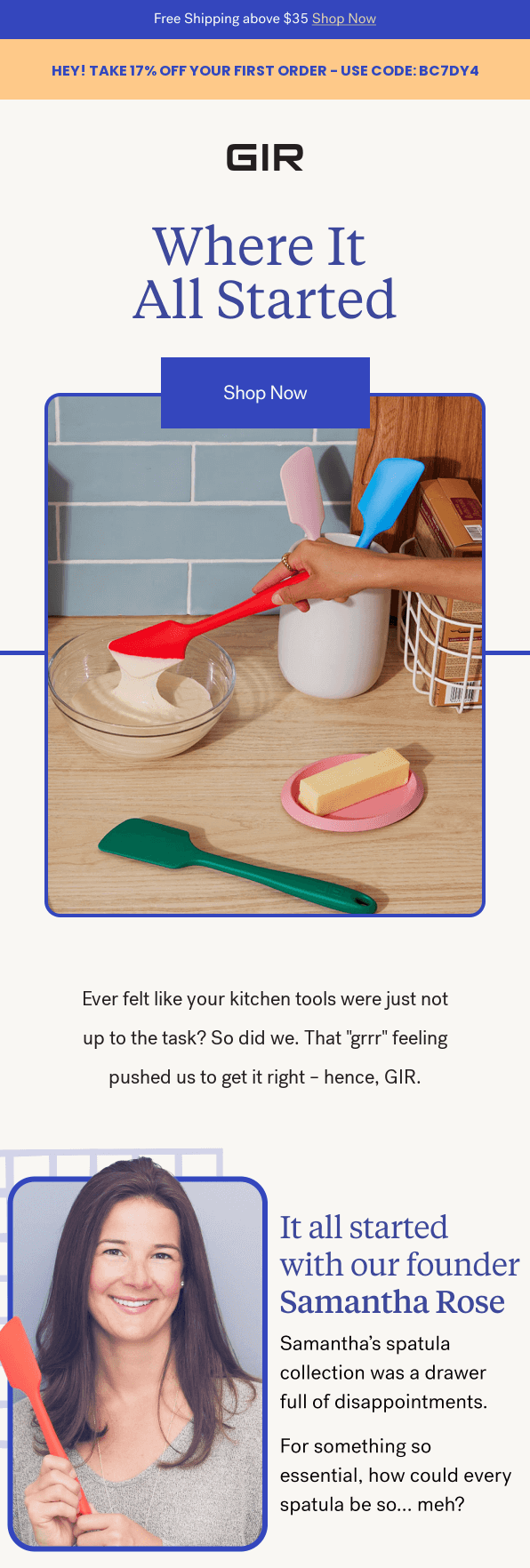
Save time and grow faster! Automate your emails with Sender’s prebuilt workflows — effortless, effective, and ready to go.
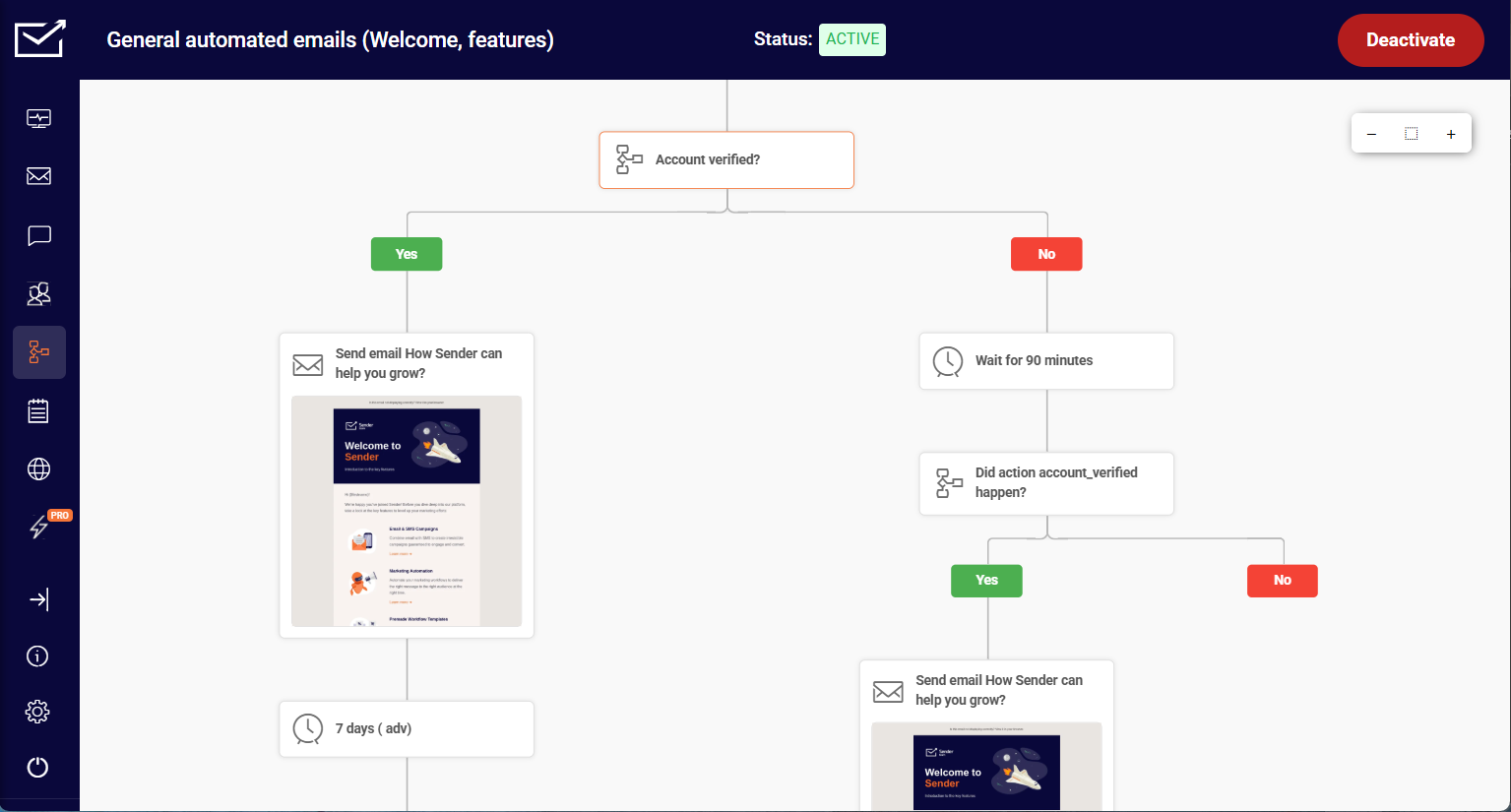
Newsletter Emails
Want to keep your audience engaged and informed about your brand? Newsletter emails are your solution! These regularly scheduled emails deliver valuable content to your subscribers, fostering a sense of community and keeping your brand top-of-mind.
To maximize the effectiveness of your newsletter emails and boost your overall email marketing campaigns, consider these variations:
- The curator. This newsletter shares a curated selection of relevant articles, industry news, and resources that your audience will find valuable, positioning your brand as a thought leader;
- The company update. This newsletter focuses on internal news, updates, and achievements. It’s a great way to keep your audience informed about what’s happening behind the scenes;
- The product focused newsletter. This newsletter showcases new product releases, features, or updates. It’s ideal for keeping your audience excited about your offerings and driving sales.
The Black Tux excels at email marketing, demonstrating how to create effective newsletters that go beyond simple product promotion. Instead of directly pushing their suits, they first offer valuable style advice:

Seasonal Marketing Emails
Seasonal marketing emails are your opportunity to connect with your audience on a festive level and drive sales during peak shopping periods. These emails leverage the spirit of specific holidays or seasons to promote relevant products, offer exclusive deals, and build stronger customer relationships.
To make the most of seasonal marketing emails and boost your email marketing campaigns, consider these highly popular approaches:
- Holiday-themed promotions. These emails center around major holidays like Christmas, Valentine’s Day, or Halloween, offering special discounts, gift guides, or themed product bundles;
- Seasonal sales events. These emails promote sales events tied to specific seasons, like Black Friday, Cyber Monday, or back-to-school sales.
And the best thing? Everything can be a holiday or a seasonal trend if you say it convincingly enough! Recess, for instance, celebrates the Super Bowl:
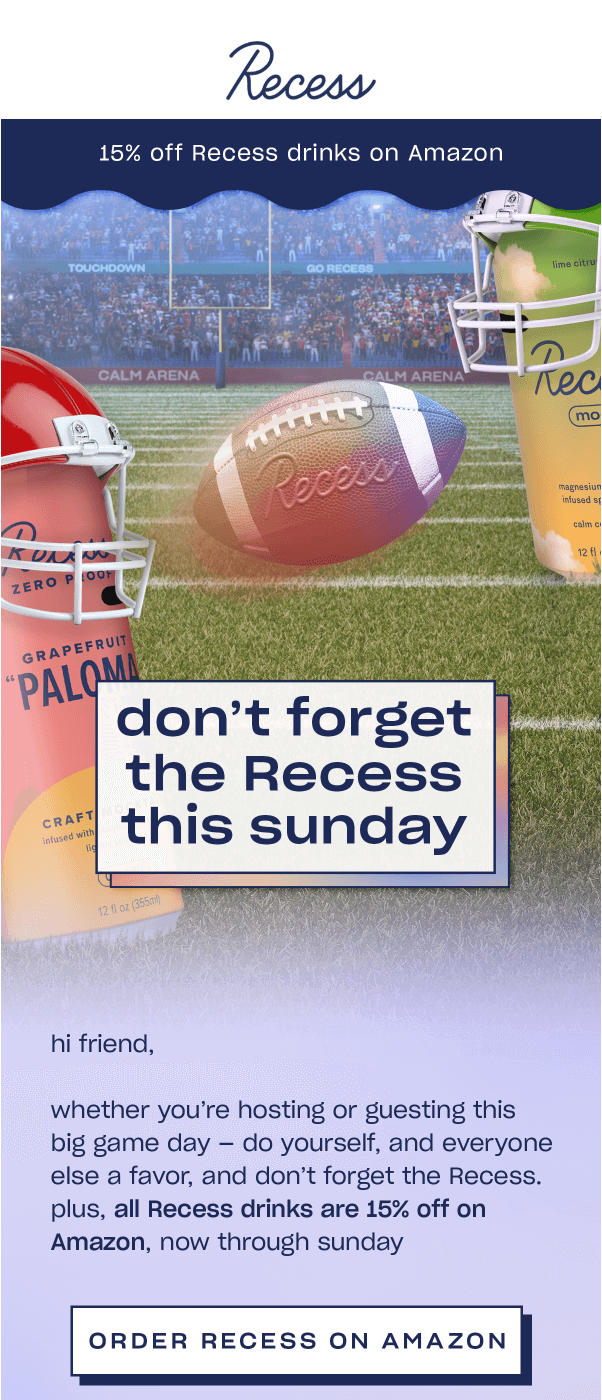
Promotional Emails (Flash Sales, Discounts)
Want to spark immediate action from existing customers? Promotional emails are your go-to! These are all about creating a sense of excitement and urgency, often featuring limited-time offers, shiny new product launches, or exclusive discounts that your subscribers won’t want to miss.
If you want to see the financial benefits of email marketing, these two types of promotional emails should make into your list:
- Discount emails. These emails offer a price reduction on your products or services, enticing subscribers to purchase.
- Flash sale emails. These emails create a sense of urgency by offering limited-time discounts and encouraging immediate action from your subscribers.
Looking at MeUndies’ email, you can see why flash emails are so effective – you get a great deal but only for a limited time, tempting you to go… no, to run to the online store:
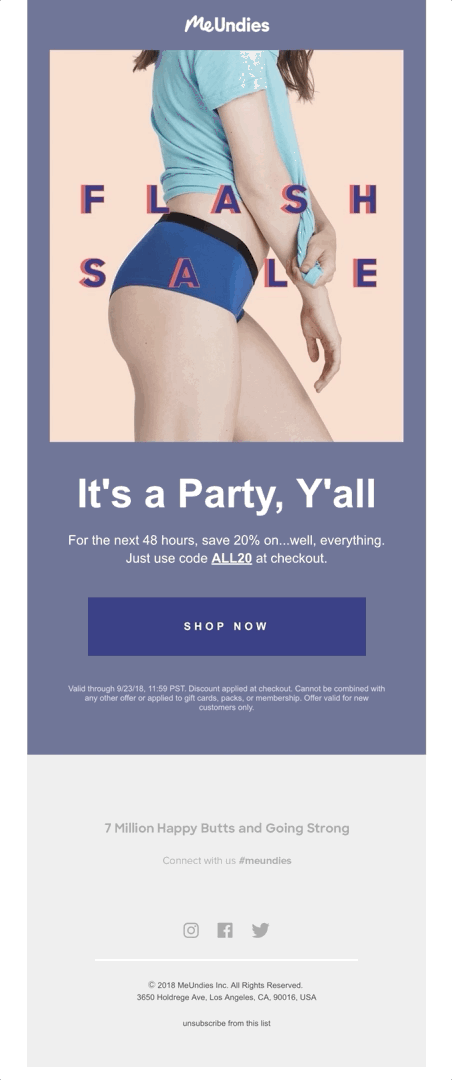
Informational Emails (Newsletters, Product Updates)
Informational emails provide valuable information to subscribers, sharing industry insights, company news, or helpful tips related to your products or services. They are a fantastic way to stay top-of-mind and position yourself as a trusted resource within your industry.
These are the two most encountered informational emails:
- How-to guides and tutorial emails offer practical advice and step-by-step instructions that help your subscribers solve a problem or learn a new skill;
- Product update emails are focused explicitly on announcing new products, features, or improvements to existing offerings.
For example, Miro always introduces its subscribers to product updates via email to ensure a constant stream of audience engagement:

Re-engagement Campaigns
Want to reconnect with inactive subscribers and reignite their interest in your brand? Try re-engagement email campaigns. These targeted emails aim to rekindle the relationship with subscribers who haven’t opened or clicked your emails in a while.
To create effective re-engagement emails you’ll need email marketing automation and to consider at least one of these two popular tactics:
- The “We Miss You” email. A simple, direct email acknowledging their absence and offering a small incentive, like a discount or exclusive content, to encourage them to re-engage;
- The win-back offer email. Present a compelling offer, such as a significant discount or free gift, to entice inactive subscribers to purchase and re-engage with your brand.
If these tactics don’t work, you can inform your subscribers that they’ll be nearly missed, like Belgian Boys did. Maybe there was a mistake after all?
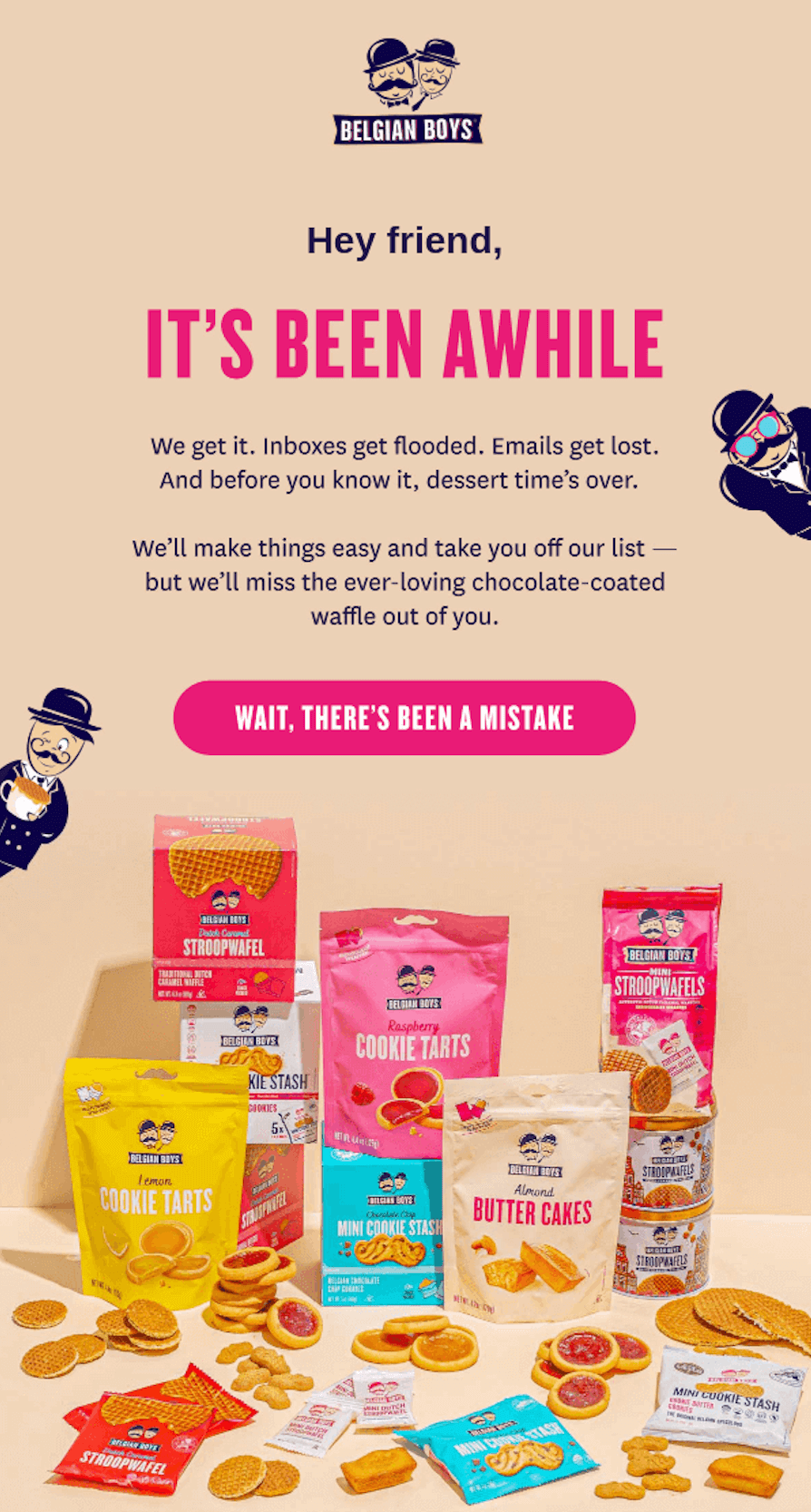
Transactional Emails (Order Confirmations, Shipping Updates)
Transactional emails are behind-the-scenes heroes triggered by specific customer actions like purchasing or creating an account.
These include order confirmations, shipping notifications, and those “reset your password” emails we all need sometimes. They’re essential for a smooth and enjoyable customer experience.
Let’s take a closer look at the two most common transactional emails:
- Order confirmation email. This email is automatically sent to customers after they place an order, confirming their purchase and providing order details.
- Shipping update email. This email is sent when an order has shipped, providing the customer with tracking information and an estimated delivery date.
Sure, an order confirmation email is fun. But you know what’s even better? Shipping update email when you know that the order is on its way! And Onyx Coffe Lab knows it perfectly:
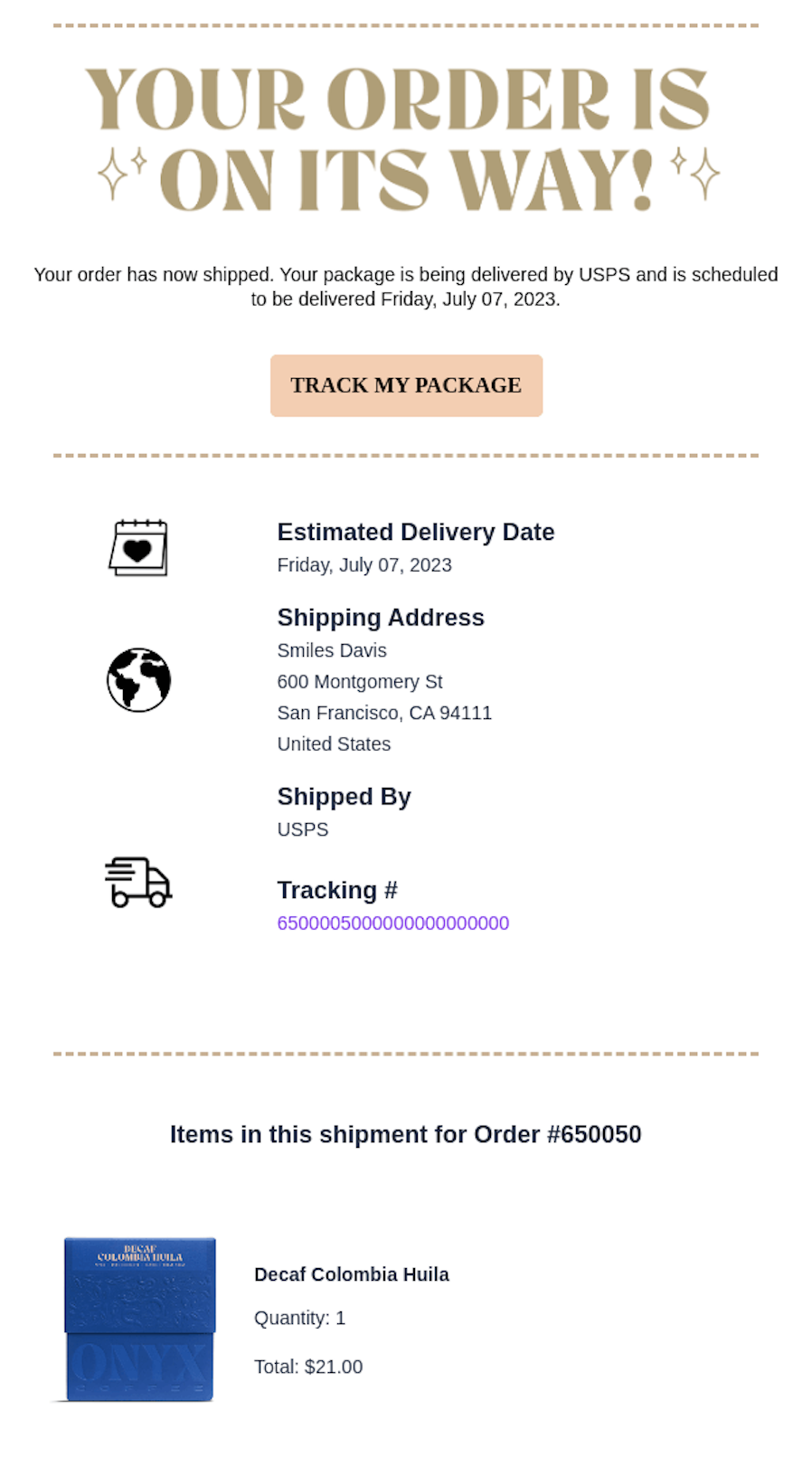
The Benefits of Email Marketing
Think email is old news? Think again! Whether you’re email marketing for beginners or you’re looking to level-up your existing email marketing campaigns, it’s clear that email still packs a punch. Because it offers a direct line to your audience, helps you build lasting relationships, and delivers real results like more sales and happier customers.
High ROI vs. Other Marketing Channels
Email marketing ROI (Return on Investment) is the most impressive compared to other marketing channels. You get more bang for your buck! A well-crafted email marketing strategy can result in a significant boost to your bottom line. This is one of the most important advantages of email communication.
Don’t believe us? Let’s compare the average ROIs of different marketing channels:
- Email marketing – $36 to $40 for every $1 spent;
- SEO (Search Engine Optimization) – $7.48 for every $1 spent;
- Influencer marketing – $5.78 for every $1 spent;
- Pay-Per-Click (PPC) advertising – $2 for every $1 spent;
- Video marketing – $1.3 for every $1 spent.
Direct and Personalized Communication
Email lets you speak directly to your audience in a way that other types of email campaigns don’t; even better, you can personalize these conversations.
By segmenting your email lists, you can tailor your messages based on demographics, interests, or past purchases. These are the components of a marketing email that make it so powerful.
Learn more about it here: Email Personalization Unlocked: 12 Strategies You Can’t Miss
Easy Customer Retention
Keeping your customers happy and coming back for more is easy with email marketing.
By nurturing those relationships through targeted content and exclusive offers, you increase their lifetime value and reduce churn rate (meaning fewer goodbyes!). The impact of email marketing for small businesses can be huge because of this.
More Sales
Want more sales? Don’t just hope for the best – use email marketing to make it happen! Email lets you connect directly with your audience, offering a personalized touch that generic advertising just can’t match.
One of the biggest advantages of email communication is building relationships that translate into sales. By sharing valuable content, showcasing your products in enticing ways, and offering exclusive deals, you encourage subscribers to become loyal customers.
Stronger Customer Loyalty
Imagine a world where your customers are your biggest fans. Email marketing makes it possible! By consistently providing value, addressing their needs, and rewarding their loyalty, you strengthen those customer relationships, leading to increased brand advocacy and repeat purchases.
Strong customer engagement is one of the biggest benefits of email marketing and one of the core principles of email marketing basics.
How to Start With Email Marketing
Here’s your step-by-step guide on how to start email marketing:
Define Your Strategy
A successful email marketing campaign requires more than just sending emails — it needs a well-defined strategy. This involves understanding your audience, setting clear goals, and choosing the right approach.
Common Email Marketing Strategies
Several proven strategies can help you achieve your email marketing goals. Choosing the right approach depends on your specific business objectives and target audience.
Some popular email marketing strategies are:
- Personalized email campaigns. Tailoring emails based on individual subscriber data, such as past purchases or browsing behavior, leads to significantly higher engagement. Personalized emails have been shown to achieve open rates of 29% and click-through rates of 41%.;
- Segmented email lists. Dividing your subscriber list into smaller groups based on shared characteristics (demographics, interests, purchase history) allows for more targeted messaging. Segmented campaigns have an average open rate 14.31% higher than non-segmented campaigns;
- Automated email sequences. Triggered emails based on specific actions, such as welcome emails for new subscribers or abandoned cart reminders, streamline communication and improve conversion rates. For instance, welcome emails have an average open rate of 83.63%, significantly surpassing the 40.08% average for general newsletters;
- Promotional email campaigns. Offering limited-time discounts, promoting new products, or announcing special events can drive immediate sales. 59% of consumers state that marketing emails affect their purchase decisions, with over 50% purchasing from an email at least monthly;
- Newsletter marketing. Regularly sending newsletters with valuable content keeps your audience engaged and strengthens brand loyalty. For instance, 71% of B2B marketers use email newsletters as part of their content marketing strategy.
Choose Email Service Provider
Selecting the right email service provider (ESP) is crucial for successful email marketing. Your ESP is your command center, providing the tools and features you need to create, send, and analyze your campaigns. Choosing the wrong provider can lead to deliverability issues, limited functionality, and a poor return on your investment.
One top recommendation, often lauded for its balance of features and affordability, is Sender. This cheap email marketing platform comes with robust email marketing automation, powerful analytics, and a user-friendly interface, making it a great option for businesses of all sizes.
Challenge the saying “You have to spend money to make money”. Create a free account and start emailing at absolutely no cost.
Sender makes it incredibly easy to connect with your audience using an intuitive dashboard, human-friendly drag-and-drop email builder, and customizable templates.
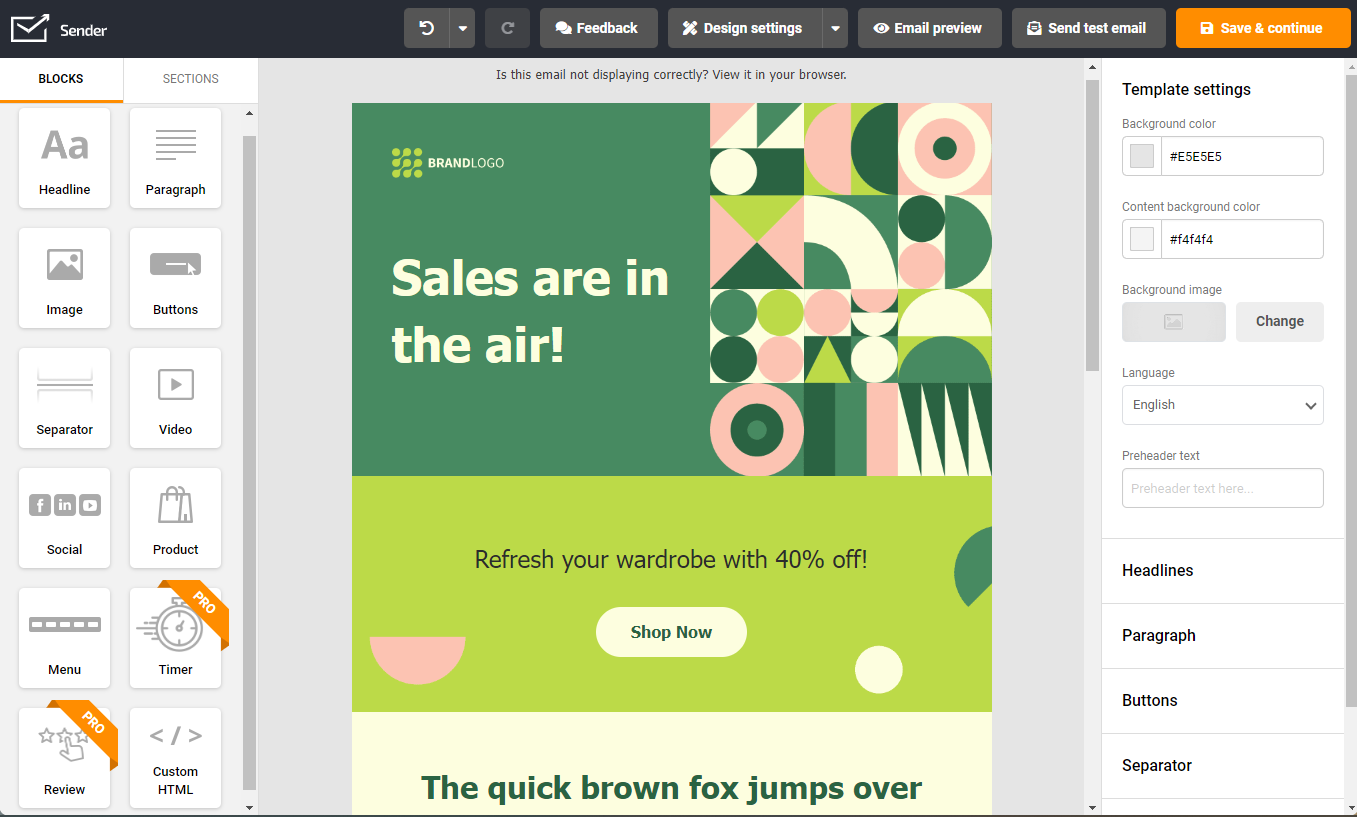
However, the “best” ESP truly depends on your specific needs and budget. Exploring different options is crucial. Here are a few other popular providers to consider:
- Constant Contact. Known for its ease of use and excellent customer support, making it a good choice for beginners;
- Klaviyo. A strong platform for e-commerce businesses, with advanced features for personalization and segmentation;
- ActiveCampaign. Offers a comprehensive suite of marketing automation tools, ideal for businesses looking to streamline their workflows;
- AWeber. A solid all-around ESP with a long track record, offering a good balance of features and affordability.
Email Marketing Platforms Features
As you saw, there are plenty of great email marketing software solutions available. When choosing yours, consider factors like:
- Ease of use. Look for a platform with an intuitive drag-and-drop interface for creating visually appealing emails.
- Email templates. Good email marketing platforms should offer pre-designed templates or customization options to simplify the email creation process.
- Automation capabilities. Choose a platform that allows you to automate email sequences based on subscriber behavior or triggers.
- Segmentation options. Ensure your chosen platform allows you to segment your audience based on demographics, interests, or purchase history.
- Analytics and reporting. Pick a platform that provides detailed insights into email opens, clicks, conversions, and other key metrics.
- Pricing. Each email service provider offers a range of pricing plans based on features and the number of subscribers.
Build Your Contact List
Building a high-quality email contact list is the foundation of effective email marketing. There’s no other way to say it – subscriber management is crucial for success.
But why is building a quality list so important? Simply put, it’s about sending the right message to the right people. A targeted, engaged email list allows you to connect with individuals genuinely interested in your brand, leading to higher open rates, click-through rates, and ultimately, conversions. Focusing on quality over quantity ensures your marketing efforts reach a receptive audience, maximizing your return on investment.
So, where do you start?
Add Signup Forms to Your Website
Strategically placing signup forms throughout is the straightest way to grow your email list. By offering tempting incentives like exclusive content or discounts in exchange for email addresses, you can significantly increase your signup rate.
While conversion rates vary depending on industry, website traffic, and the attractiveness of your offer, even a small improvement in signup rate can significantly impact your email list growth over time. For example, increasing your conversion rate from 1% to 2% effectively doubles your subscriber acquisition.
Consider these high-traffic areas for maximum visibility:
- Homepage. Capture visitors’ attention immediately upon arrival;
- Blog sidebar. Provide a consistent signup option for engaged readers;
- End of blog posts. Convert readers who enjoyed your content into subscribers;
- About us page. Attract visitors genuinely interested in your brand.
Make sure your signup form is visually appealing and easy to use. Minimize the required fields (name and email address are often sufficient) to reduce friction and encourage signups.
Here are some different types of signup forms and pop-ups to consider:
- Embedded forms. These forms are integrated directly into your website’s layout, often appearing in sidebars or footers. They provide a consistent signup option without interrupting the user experience;
- Pop-up forms. These forms appear as overlays on your website, grabbing the visitor’s attention. Use them strategically to avoid annoying visitors. Consider exit-intent pop-ups, which appear when a user is about to leave your site;
- Gamified forms. These forms incorporate interactive elements like spin-to-win wheels or quizzes to make signing up more engaging and fun.
Use Lead Magnets
Everyone loves freebies! Offer valuable resources like ebooks, checklists, or webinars as lead magnets to entice website visitors to join your email list.
This is a great start for lead nurturing because it provides immediate value to potential customers while simultaneously allowing you to capture their contact information. This sets the stage for building relationships, sharing relevant content, and eventually guiding them towards purchasing.
When you enter Vesta Coffee’s website, you’re immediately met with a compelling signup form and an alluring discount on its products. Chances are you’ll subscribe even before scrolling down the page!
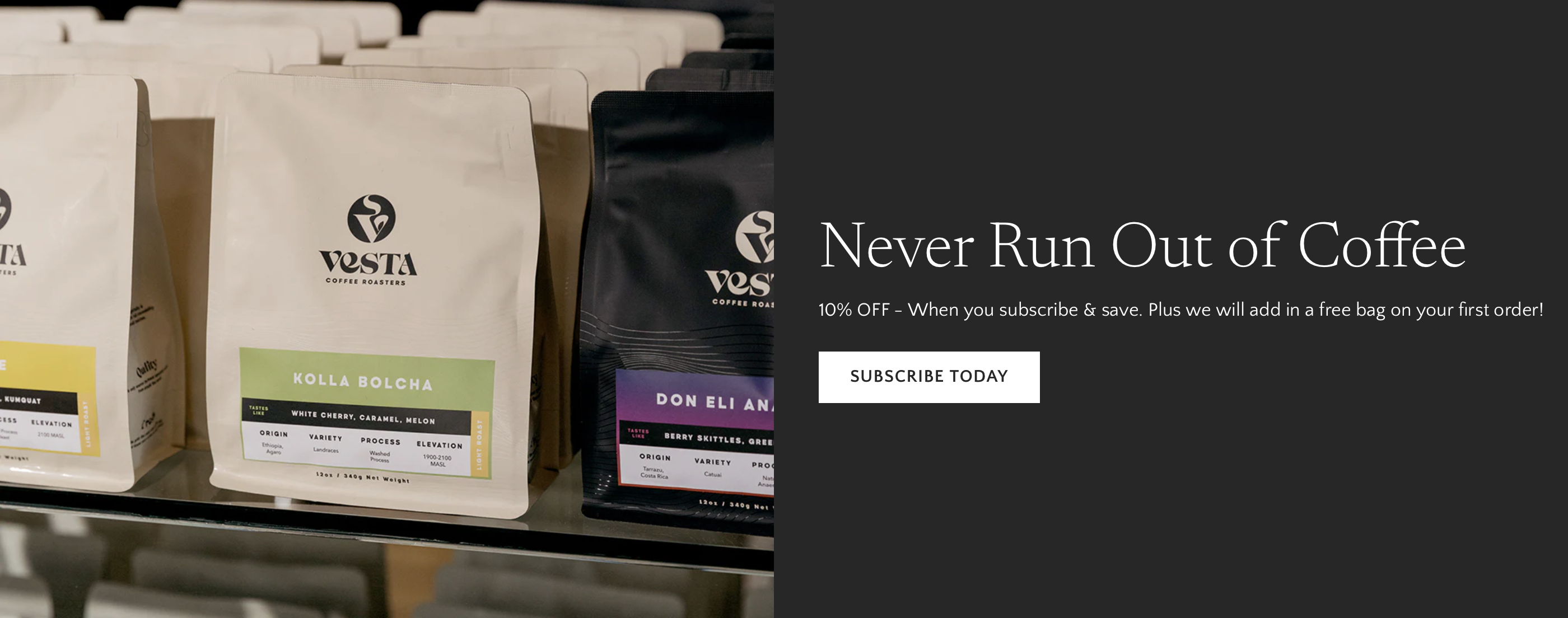
Write an Effective Marketing Email
You’ve built your list, chosen your ESP, and defined your strategy – now it’s time to craft compelling emails that get results. From attention-grabbing subject lines to engaging copy and eye-catching design, every element plays a role in capturing your reader’s attention and driving conversions.
Let’s break down the key ingredients of a high-performing marketing email.
Optimize Open Rates
Before your email’s content can work its magic, people need to actually open it. Optimizing your open rates is the first critical step in a successful email marketing campaign. A high open rate indicates that your subject line, preheader text, and sender name resonated with your audience, enticing them to click and see what’s inside.
So, here’s how you can maximize those all-important opens:
Subject line
This is your first (and often only) impression. A compelling subject line is crucial for grabbing attention and sparking curiosity. So:
- Keep it concise. Aim for around 50 characters or less to avoid truncation on mobile devices;
- Create intrigue. Use questions, numbers, or power words to pique interest;
- Personalize when possible. Include the recipient’s name or location for a more personal touch;
- Avoid spam triggers. Refrain from using excessive exclamation points, all caps, or misleading phrases;
- A/B test different subject lines. Experiment to see what resonates best with your audience.
Preheader text
This short snippet of text appears after the subject line in many email clients. Use it to expand on your subject line and provide additional context:
- Reinforce your message. Complement your subject line and further entice recipients to open;
- Highlight a key benefit. Showcase the value they’ll receive by opening the email;
- Create a sense of urgency. Use phrases like “limited-time offer” or “don’t miss out.”
Sender name
This tells recipients who the email is from. A sender name can increase the likelihood of opens. But only if you:
- Use your brand name. This reinforces brand recognition and builds trust;
- Combine your brand and a personal name. For example, “Sarah from [Your Brand]” can add a personal touch;
- Maintain consistency. Avoid frequently changing your sender name to prevent confusion.
Focus on Design
The design of your email plays a crucial role in engaging your audience and conveying your message effectively. A visually appealing and well-structured email encourages recipients to read your content and take action.
Consider these key design elements:
- Mobile optimization. Ensure your emails render correctly on all devices, including smartphones and tablets. Most people check their email on mobile, so a mobile-friendly design is essential;
- Visual hierarchy. Use headings, subheadings, bullet points, and images to break up text and guide the reader’s eye. A clear visual hierarchy makes your email easier to scan and digest;
- Branding. Incorporate your brand colors, fonts, and logo to reinforce brand recognition and maintain a consistent visual identity;
- Images and videos. Use high-quality visuals to enhance your message and capture attention. However, avoid using too many images, as this can slow down load times and affect deliverability;
- Call to action. Make your call to action clear and prominent. Use a button with contrasting colors and compelling text to encourage clicks;
- White space. Don’t overcrowd your email with too much text or visuals. Use white space strategically to create a clean and uncluttered look.
Write Compelling Email Copy
The words you use in your email are just as important as the design. Compelling copy engages your audience, conveys your message clearly, and motivates them to take action.
Follow these tips for writing effective email copy:
- Know your audience. Tailor your language and tone to resonate with your target audience;
- Focus on benefits. Highlight the value your readers will receive by taking action;
- Keep it concise. Use short, punchy sentences and paragraphs to make your email easy to read;
- Use a conversational tone. Write as if you’re speaking directly to the recipient;
- Personalize when possible. Use the recipient’s name and other relevant data to create a more personal connection;
- Create a sense of urgency. Encourage immediate action by using phrases like “limited-time offer” or “don’t miss out;”
- Proofread carefully. Errors in grammar and spelling can damage your credibility;
- Include a clear CTA. Tell your readers exactly what you want them to do.
Fly by Jing’s emails always tick all the boxes in an excellent email design and copy list. Starting with great email subject lines – in this case, “Recipes for RAD DADS 🤴.”

When to Send Your Emails
Timing is everything! Experiment with different days and times to see when your audience will most likely open and engage with your emails. You can also use your email marketing tool to schedule emails in advance.
All in all, here’s how you decide on the best timing:
- Analyze your email marketing data to see when your subscribers are most active;
- Consider time zones if you have a global audience;
- Test different send times and days to see what works best for your audience.
Email Marketing Best Practices
While there’s no guaranteed formula for a perfect email marketing campaign every single time, following these email marketing best practices will significantly increase your chances of success:
Never Buy Email Lists
Purchasing email lists might seem like a shortcut to a larger target audience, but it’s a shortcut straight to the spam folder and a surefire way to damage your sender reputation, impacting your email deliverability. It can also violate the CAN-SPAM Act, leading to hefty fines. Building an organic list ensures higher engagement and better performance of future campaigns.
Segment Your Audience for Personalization
Segmenting your audience allows you to send personalized emails tailored to specific interests, leading to higher engagement and click-through rates.
- Improved email marketing metrics. Personalized emails resonate better with recipients, leading to increased open rates, click through rates, and conversions;
- Enhanced customer engagement. Sending relevant content strengthens customer relationships and fosters loyalty;
- Targeted email marketing campaigns. Segmentation enables you to create highly targeted email marketing campaigns that address specific needs and interests;
- Effective marketing automation. Most email marketing services offer tools to segment your audience and automate personalized email delivery;
- Increased ROI. By sending the right message to the right people, you increase the effectiveness of your email marketing efforts and drive sales more efficiently.
Avoid Spam Filters
Nobody wants their meticulously crafted email marketing campaigns to end up in the spam folder. Understanding how spam filters work is crucial for maintaining good email deliverability.
So, always make sure you follow these email deliverability tips:
- Use a reputable email marketing service. These services often have built-in tools and authentication measures to help improve your email deliverability;
- Implement double opt-in. It confirms that subscribers genuinely want to receive your emails, reducing spam complaints;
- Avoid spam trigger words. Certain words and phrases can trigger spam filters;
- Maintain a clean email list. Regularly remove inactive or bounced email addresses to improve your sender reputation;
- Monitor email marketing metrics. Keep track of your deliverability rates, bounce rates, and spam complaints to identify potential issues and optimize accordingly.
Use Compelling Subject Lines and CTAs
Your subject line is the first impression you make. A compelling subject line can significantly improve your open rates, while a clear and concise CTA is essential for driving conversions.
Here’s how you make your subject lines shine:
- Create intrigue. Use engaging language that piques curiosity and encourages recipients to open your emails;
- Keep it concise. Long subject lines can get truncated, especially on mobile devices. Aim for brevity and clarity;
- A/B test subject lines. Experiment with different subject lines to see which ones perform best with your target audience;
- Personalize when possible. Incorporating the recipient’s name or other relevant information can increase open rates. This ties in nicely with your broader email personalization efforts and ultimately contributes to more effective email marketing campaigns.
As for CTAs, ensure they’re strong. Tell your recipients exactly what you want them to do, whether it’s “Shop Now,” “Learn More,” or “Download Today.
Email Marketing FAQs
Why is email marketing important?
In a world saturated with information, email marketing provides a direct line to your audience, allowing you to build lasting connections and drive conversions. This highlights the importance of email marketing as a dedicated space to share valuable content and personalized messages that resonate with your subscribers.
Email marketing explained: it’s a powerful tool for nurturing leads and guiding potential customers through their buying journey. You can turn subscribers into loyal customers by offering tailored communication and addressing their needs.
It’s also an effective way to announce new products, promote special offers, and keep your audience engaged with your brand, all essential elements of a successful email marketing campaign.
But don’t just trust us – see what the latest statistics are saying:
- Email marketing generates, on average, $36 for every dollar spent.
- The email marketing market was $12 billion in 2024, surpassing $7.5 billion in 2020.
- 41% of marketers admit that email is their most effective marketing channel.
- The average revenue per email will increase from 12.9 cents to 17 cents by 2026.
- 63% of marketers said they planned to increase their email program’s volumes in 2024.
What are the key email marketing metrics?
Key email marketing metrics measure the effectiveness of your email marketing campaigns. Analyzing them helps optimize campaign performance.
Here are the key metrics you should analyze:
- Open rates. Percentage of recipients who opened your email. Indicates subject line effectiveness and deliverability;
- Click-through rates (CTR). Percentage of recipients who clicked a link. Reflects content and call-to-action effectiveness;
- Conversion rates. Percentage of recipients who completed a desired action after clicking. Shows campaign effectiveness in achieving goals;
- Bounce rates. Percentage of undelivered emails. High rates hurt sender reputation;
- Unsubscribe rates. Percentage of recipients who opted out. High rates suggest content, frequency, or targeting issues.
